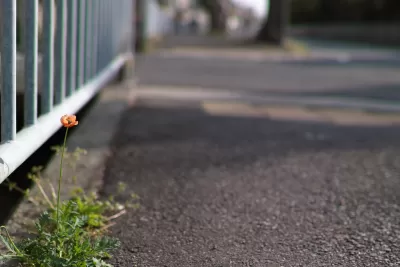Paved surfaces take up close to a third of space in U.S. cities, polluting waterways and contributing to the urban heat island effect.

As planners reevaluate the impacts of urban freeways and work to undo the damage done to urban neighborhoods, writes Mary Pat McGuire, they should also consider "another harmful infrastructure" that has, in many cases, taken over much urban space: "the extraordinary amount of pavement in U.S. cities that has come to characterize urban life."
Taking up 30% of city surfaces, pavement "pollutes waterways through rapid run-off, generates flooding in neighborhoods, and activates temperature rise through the urban heat island effect." As such, planners should look for ways to remove pavement in favor of healthier alternatives.
Approximately 93% of roads are paved with asphalt. Asphalt is a 19th-century technology which is impervious to stormwater, includes a crude oil binder, and releases harmful air pollutants and carcinogens. The human impact is felt through urban flooding, heat waves, and respiratory health problems. Notably, the distribution of that pavement is disproportionately felt by the absence of shade trees in low-income areas.
"Given that we have more streets and parking than truly needed, removal of this harmful infrastructure is a necessary part of urban adaptation and climate justice." But removing pavement requires a different approach than freeway removal, McGuire writes. "Somewhat different from a single highway coming out, depaving city streets and parking lots entails a more distributed, systemic approach." Successful examples include "initiatives like Depave in Portland and Space to Grow in Chicago," which "have worked with numerous schools in each respective city to transform asphalt playgrounds into gardens and stormwater surfaces, reconnecting people with land and with each other."
In spite of historic resistance to the removal of infrastructure, "the severe impact of highways and pavements on the health of land, water, and people are giving us a reason to adopt a new way of thinking, as did the height of the pandemic in the U.S. when streets were appropriated for cafes and neighborhood events. In depaving our cities, we can imagine how to make those social spaces permanent — and environmentally sustainable."
FULL STORY: While We’re Considering Removing Highways, Let’s Not Overlook Pavement

Study: Maui’s Plan to Convert Vacation Rentals to Long-Term Housing Could Cause Nearly $1 Billion Economic Loss
The plan would reduce visitor accommodation by 25,% resulting in 1,900 jobs lost.

North Texas Transit Leaders Tout Benefits of TOD for Growing Region
At a summit focused on transit-oriented development, policymakers discussed how North Texas’ expanded light rail system can serve as a tool for economic growth.

Using Old Oil and Gas Wells for Green Energy Storage
Penn State researchers have found that repurposing abandoned oil and gas wells for geothermal-assisted compressed-air energy storage can boost efficiency, reduce environmental risks, and support clean energy and job transitions.

Private Donations Propel Early Restoration of Palisades Playground
Los Angeles has secured over $1.3 million in private funding to restore the Pacific Palisades playground months ahead of schedule, creating a modern, accessible space that supports community healing after recent wildfires.

From Blight to Benefit: Early Results From California’s Equitable Cleanup Program
The Equitable Community Revitalization Grant (ECRG) program is reshaping brownfield redevelopment by prioritizing projects in low-income and environmental justice communities, emphasizing equity, transparency, and community benefits.

Planting Relief: Tackling Las Vegas Heat One Tree at a Time
Nevada Plants, a Las Vegas-based nonprofit, is combating the city’s extreme urban heat by giving away trees to residents in underserved neighborhoods, promoting shade, sustainability, and community health.
Urban Design for Planners 1: Software Tools
This six-course series explores essential urban design concepts using open source software and equips planners with the tools they need to participate fully in the urban design process.
Planning for Universal Design
Learn the tools for implementing Universal Design in planning regulations.
Ascent Environmental
Borough of Carlisle
Institute for Housing and Urban Development Studies (IHS)
City of Grandview
Harvard GSD Executive Education
Toledo-Lucas County Plan Commissions
Salt Lake City
NYU Wagner Graduate School of Public Service


























